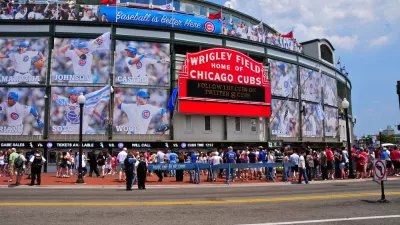The Wrigleyville neighborhood of Chicago will have a national audience this week for the first time since 2003. The neighborhood has changed, and is poised for even more change.
Rachel Crosby describes the changes that have swept across the neighborhood of Wrigleyville in Chicago. Over a timeline of 30 years, a rough and tumble" neighborhood has given way to busy bars, flags that say "Cubs" and "W" lining the streets, and the smell of stale beer. On that later point, the proliferation of bars in the area is one of the noticeable changes described in the article.
At the enter of the neighborhood is Wrigley Field, home of the Chicago Cubs—the third most visited of all the ticketed places in the city. "Yet if Wrigley Field is the heart of Wrigleyville, the 80 or so neighboring bars and businesses are its lifeblood. They stretch down Clark and up Sheffield and are speckled farther out, in between houses and condos and apartments around Lakeview," writes Crosby.
But a $575 million development project is underway at the ballpark, which the teams can provide a catalytic development for the neighborhood. The hope is that the new development will inspire visitors to stay, rather than just visit.
The Cubs are doing their part in changing the perception of the neighborhood, by hosting games in the National League Championship Series. "Outside bars, signs on the street ask patrons to be quiet and respect neighbors. It's a problem that's grown parallel to the bar scene's evolution. But on days like Tuesday, when the Cubs clinched the National League Division Series for the first time at home, it's hard to hold back the celebration."
FULL STORY: Wrigleyville on brink of new era

Alabama: Trump Terminates Settlements for Black Communities Harmed By Raw Sewage
Trump deemed the landmark civil rights agreement “illegal DEI and environmental justice policy.”

Planetizen Federal Action Tracker
A weekly monitor of how Trump’s orders and actions are impacting planners and planning in America.

The 120 Year Old Tiny Home Villages That Sheltered San Francisco’s Earthquake Refugees
More than a century ago, San Francisco mobilized to house thousands of residents displaced by the 1906 earthquake. Could their strategy offer a model for the present?

In Both Crashes and Crime, Public Transportation is Far Safer than Driving
Contrary to popular assumptions, public transportation has far lower crash and crime rates than automobile travel. For safer communities, improve and encourage transit travel.

Report: Zoning Reforms Should Complement Nashville’s Ambitious Transit Plan
Without reform, restrictive zoning codes will limit the impact of the city’s planned transit expansion and could exclude some of the residents who depend on transit the most.

Judge Orders Release of Frozen IRA, IIJA Funding
The decision is a victory for environmental groups who charged that freezing funds for critical infrastructure and disaster response programs caused “real and irreparable harm” to communities.
Urban Design for Planners 1: Software Tools
This six-course series explores essential urban design concepts using open source software and equips planners with the tools they need to participate fully in the urban design process.
Planning for Universal Design
Learn the tools for implementing Universal Design in planning regulations.
Clanton & Associates, Inc.
Jessamine County Fiscal Court
Institute for Housing and Urban Development Studies (IHS)
City of Grandview
Harvard GSD Executive Education
Toledo-Lucas County Plan Commissions
Salt Lake City
NYU Wagner Graduate School of Public Service





























